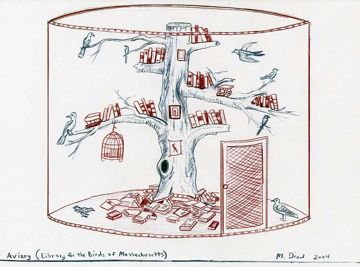
Mark Dion, Drawing for "Aviary (Library for the Birds of Massachusetts)" 2005 Courtesy Tanya Bonakdar Gallery, New York
Revving up for the new school year I have had the chance to read quite a bit over the past two weeks, and in addition to the recommendations from June 30th I reached into some of my favorite faded paperbacks and read The Razor’s Edge by W. Somerset Maugham. The story, if you haven’t already read it multiple times in your teens or twenties, follows Larry Darrell through his quest for a spiritual existence as his entire life seems to orbit around friends and family that cling to all things material and elite. But Larry hammers away. He travels. He seeks. He asks lots of questions. He sacrifices certain things to learn others.
The dog days of August are the time to ask lots of questions of ourselves as educators. This is the time to perhaps plan differently and seek even better ways of achieving the overarching goals that define our curriculum. What are the big questions students will investigate in our classes? What are the themes that guide our curriculum? What will our classrooms look and sound like? What will our courses, and the work, be about? What are the big things students will know and be able to do once they finish our courses?
One of the improvements I’d like to initiate this year in my own classes, picking up on an interview I read featuring season 4 artist Mark Dion, is to get more students to consider their relationship to museums and how they engage with objects in museums. Dion states in Phaidon’s Press Play (2005) that museums are continually pressured to entertain and educate what they perceive as younger audiences, and this has forced them to dumb down exhibitions for visitors. Rather than provoke questions, museums more often provide scripted answers. One of the difficult tasks I face this year is making students realize that museums are places to challenge ourselves and ask questions that can lead to understanding more than just the work on display. Good questions, as well as meaningful “front end” work prior to a museum visit, can make a huge difference in how students experience art in person.
In next week’s column, I’d like to talk a little bit about what good museum visits have in common with teaching using film and video in the classroom. See you then. Stay cool. And remember… Teaching with Contemporary Art hits the blog every Wednesday afternoon for your shopping convenience.



